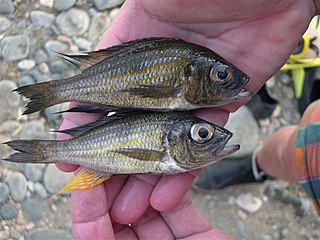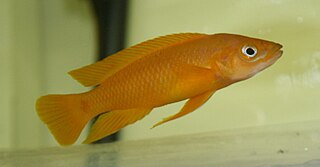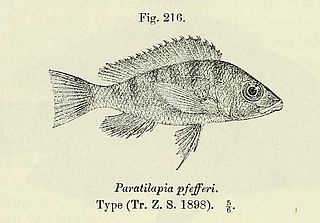Nanochromis transvestitus is a sexually dimorphic cichlid endemic to Lake Mai-Ndombe in the Democratic Republic of the Congo where they live at a depth of around 1 metre (3.3 ft). It feeds on small benthic invertebrates. This species reaches a length of 3.4 centimetres (1.3 in) SL. Unusually for cichlids, it is the female, not the male, that is the most colourful. The female has a vertical black and white banding on her anal and caudual fins, with a bright red abdomen. The male, by contrast, is grayish in colour. Like many cichlids, the male does, however, have longer anal and caudal fins. The fish are egg layers and make a nest in the substrate in which to lay their eggs. This species is particularly threatened by the practice of using mosquito netting to catch fish out of the lake as material with holes that small catches every species of fish in the lake regardless of size. The specific name is a derived from the Latin trans meaning "cross" or "over" and vestitus meaning "clothed", a reference to the reversal of the normal sexual dimorphism in that this species has drabber males and more colourful females.

Aulonocranus dewindti is a species of cichlid endemic to Lake Tanganyika and some rivers which flow into it.

Ectodus descampsii is a species of cichlid fish endemic to Lake Tanganyika in East Africa where it prefers areas with substrates of coarse sand. It feeds on micro-organisms, algae and diatoms. This species reaches a length of 10.4 centimetres (4.1 in) TL. It is also found in the aquarium trade. It is currently the only known member of its genus. The specific name honours Capitaine Georges Descamps (1855-1938), a Belgian officer in the anti-slavery movement at Lake Tanganyika.

Nimbochromis livingstonii, Livingston's cichlid or (locally) kalingono, is a freshwater mouthbrooding cichlid native to Lake Malawi, an African Rift Lake. It is also found in the upper Shire River and Lake Malombe. They are found in inshore areas of the lake over sandy substrates.

Neolamprologus leleupi is a species of cichlid endemic to Lake Tanganyika where it occurs throughout the lake. It is a recess-dweller, inhabiting cracks and crevices. It feeds on invertebrates living in the rich biocover of the substrate. This species reaches a length of 10 centimetres (3.9 in) TL. The color of this fish ranges from bright yellow to deep brown. Both color variations exist at each location where this species is found. This relatively small cichlid is a substrate spawner. It is easily confused with the very similar N. longior a fish also endemic to Lake Tanganyika. The specific name honours the Belgian entomologist Narcisse Leleup (1912-2001), who collected the type.

Grammatotria lemairii is a species of cichlid endemic to Lake Tanganyika in East Africa where it prefers areas with sandy substrates. This species can reach a length of 26 centimetres (10 in) TL. It is currently the only known member of its genus. The species is occasionally kept as an aquarium fish. The specific name honours Lieutenant Charles Lemaire (1863-1925) who was the leader of the Congo Free State Expedition, which collected specimens of fishes at Lake Tanganyika, including the type of G. lemairii.
Copadichromis geertsi is a species of haplochromine cichlid which is endemic to Lake Malawi.

Gnathochromis pfefferi is an African species of fish in the family Cichlidae. It is endemic to Lake Tanganyika and its slow-flowing tributaries in the countries of Burundi, the Democratic Republic of the Congo, Tanzania and Zambia. It is common and widespread. This cichlid is found in relatively shallow waters, typically over soft bottoms in places with aquatic grasses.

The convict julie is a cichlid species in the subfamily Pseudocrenilabrinae family endemic to Lake Tanganyika. Hence it is found in Burundi, the Democratic Republic of the Congo, Tanzania, and Zambia. The fish is named after Charles Tate Regan.

Lepidiolamprologus cunningtoni is a species of cichlid endemic to Lake Tanganyika where it prefers areas with sandy substrates in which it digs crater-shaped nests. This carnivorous species takes fish as prey. This species can reach a length of 29.1 centimetres (11.5 in) TL. This species inclusion in this genus has been questioned based upon its lacking many of the characteristics of its congeners. It can also be found in the aquarium trade. The specific name of this fish honours the British zoologist William Alfred Cunnington (1877-1958), who collected the type on an expedition to Lake Tanganyika.

Limnotilapia dardennii, the latticed cichlid, is a species of cichlid endemic to Lake Tanganyika, where it prefers rocky areas near the coast. It may also be found in the aquarium trade. This species is currently the only known member of its genus.

Lepidiolamprologus boulengeri is a species of cichlid endemic to Lake Tanganyika where it is known from the Tanzanian coast in the northern part of the lake. Pairs of this species live together in their territory and the female lives in snail shells in a pit that they have dug in the sand. This species can reach a length of 6.2 centimetres (2.4 in) TL. This species can also be found in the aquarium trade.
Neolamprologus buescheri is a species of cichlid endemic to Lake Tanganyika. This species can reach a length of 8 centimetres (3.1 in) TL. It can also be found in the aquarium trade. The specific name of this cichlid honours the collector of its type, the German ichthyologist Heinz H. Büscher.
The fenestratus is a species of cichlid fish endemic to Lake Malawi in East Africa. This species can reach a length of 14 centimetres (5.5 in) TL. It can also be found in the aquarium trade. Protomelas fenestratus is a substrate blower. They blow away the substrate, to uncover insect larvae and crustaceans. They are characterized by vertical bars, and thin horizontal lines of varying darkness depending on location. The males blue colouration obscures the barring when dominant. The lattice like pattern on this fish's body is reminiscent of windows which is what the specific name fenestratus refers to.

Pseudotropheus demasoni is a species of cichlid endemic to Lake Malawi where it is only known from the Pombo Rocks in Tanzanian waters. This species can potentially reach a maximum length of 10 centimetres (3.9 in) SL. It is now commonly found in the aquarium trade.

The electric blue hap is a species of cichlid fish endemic to Lake Malawi. It prefers to live in caves and crevices in rocky substrates. This species can reach a length of 20 centimetres (7.9 in) TL. It can also be found in the aquarium trade.
Pseudosimochromis babaulti is a species of cichlid endemic to Lake Tanganyika preferring areas with rock-rubble substrates. It can reach a length of 11 centimetres (4.3 in) TL. It can also be found in the aquarium trade.
Telmatochromis dhonti is a species of cichlid endemic to Lake Tanganyika where it prefers rocky substrates. This species can reach a length of 12 centimetres (4.7 in) TL. It can also be found in the aquarium trade. The specific name honours the collector of the type G. Dhont-De Bie of the Belgian East African Expeditionary Force.
Xenotilapia boulengeri is a species of cichlid endemic to Lake Tanganyika where it occurs in schools in areas with sandy substrates. Its diet consists of small shrimps and copepods. This species can reach a length of 15.3 centimetres (6.0 in) TL. It can also be found in the aquarium trade. The specific name honours the Belgian-British zoologist George Albert Boulenger (1858-1937), in recognition of his world on the fishes of Lake Tanganyika.

Tilapia sparrmanii, the banded tilapia, or vlei kurper, is a widespread and adaptable cichlid fish that is found in warmer freshwater habitats of southern Africa. They prefer water with ample plant cover, and occur naturally as far north as DR Congo and Tanzania. They have been introduced locally in the northern hemisphere. Younger banded tilapia feed on crustaceans and insect larvae, while the adults feed on terrestrial and aquatic plants and other debris. They undertake local migrations and may shoal before and during spawning time. They guard their own eggs, and although they may move eggs or fry in the mouth, they are not known to be actual mouthbrooders like several other tilapia species. This species can reach a length of 23.5 centimetres (9.3 in) TL and is an important foodfish.














